Cultural and Interpersonal Influence on Volkswagen's Consumer Behavior
VerifiedAdded on 2022/11/03
|17
|4242
|392
Report
AI Summary
This report provides a comprehensive analysis of Volkswagen's consumer behavior, focusing on the impact of cultural and interpersonal factors on its target market. The study begins with an overview of the Volkswagen Group, its products and services, and its current marketing strategies. It then delves into the cultural factors, such as mixed brand perception and shifts in consumer preferences, and interpersonal factors, including marketing mix, legal aspects, and organizational technology, that influence consumer decision-making. The report also examines the issues affecting Volkswagen's target market, particularly the emission scandal and its impact on consumer trust and environmental concerns. The analysis draws upon relevant consumer behavior theories to evaluate the identified influences. Finally, the report offers strategic recommendations to improve Volkswagen's marketing strategies, addressing the challenges and opportunities presented by the cultural and interpersonal influences on consumer behavior.
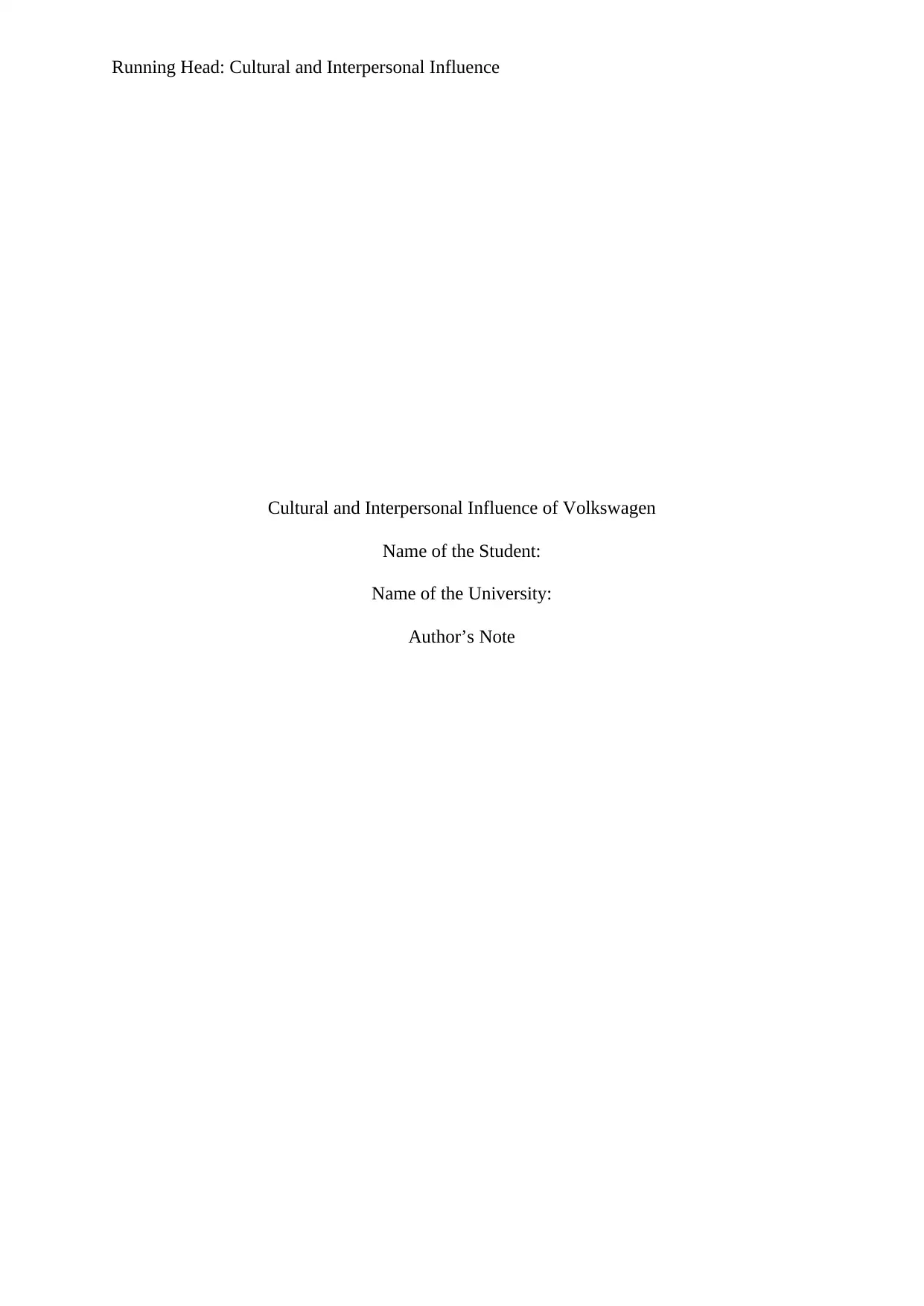
Running Head: Cultural and Interpersonal Influence
Cultural and Interpersonal Influence of Volkswagen
Name of the Student:
Name of the University:
Author’s Note
Cultural and Interpersonal Influence of Volkswagen
Name of the Student:
Name of the University:
Author’s Note
Paraphrase This Document
Need a fresh take? Get an instant paraphrase of this document with our AI Paraphraser
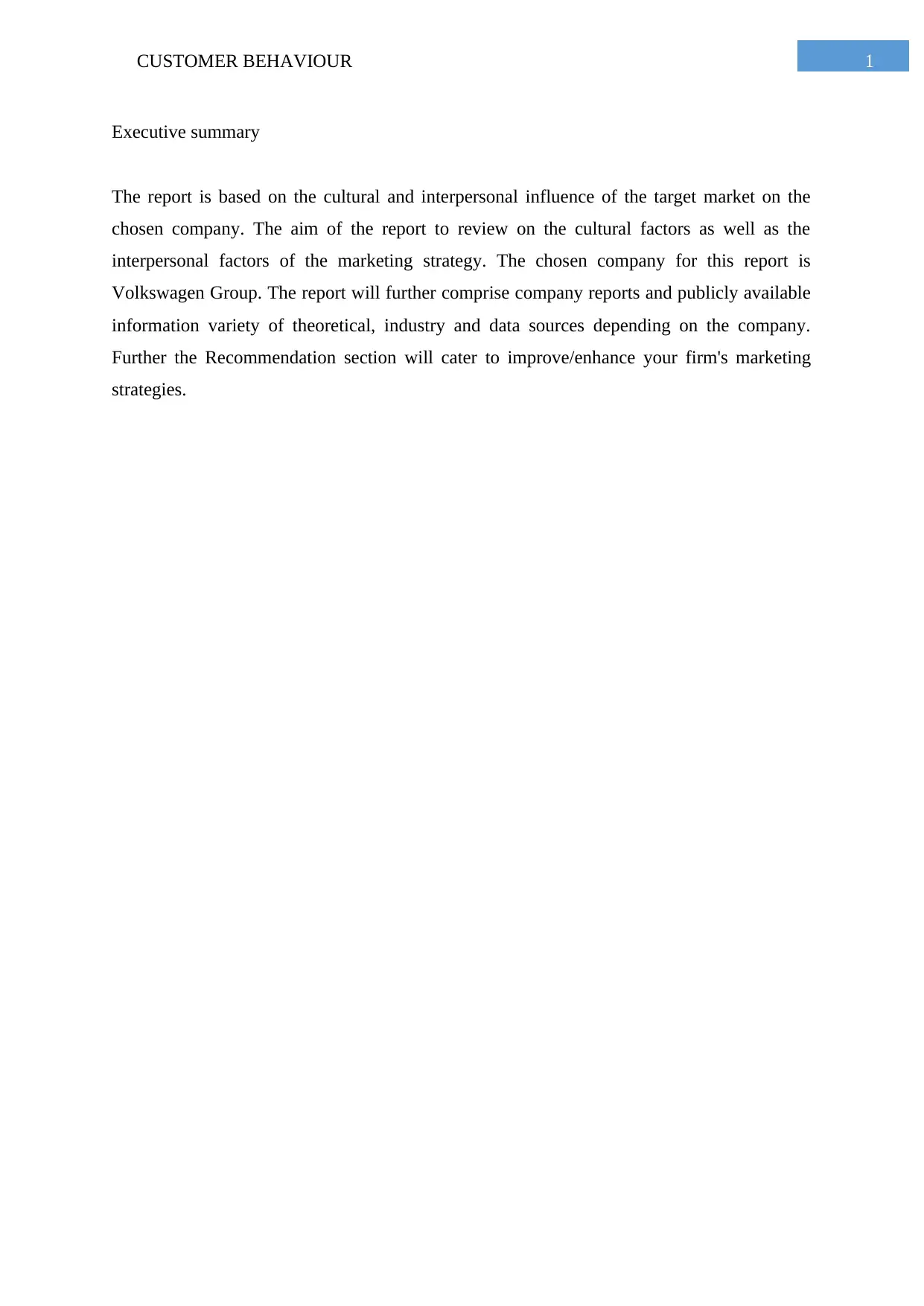
1CUSTOMER BEHAVIOUR
Executive summary
The report is based on the cultural and interpersonal influence of the target market on the
chosen company. The aim of the report to review on the cultural factors as well as the
interpersonal factors of the marketing strategy. The chosen company for this report is
Volkswagen Group. The report will further comprise company reports and publicly available
information variety of theoretical, industry and data sources depending on the company.
Further the Recommendation section will cater to improve/enhance your firm's marketing
strategies.
Executive summary
The report is based on the cultural and interpersonal influence of the target market on the
chosen company. The aim of the report to review on the cultural factors as well as the
interpersonal factors of the marketing strategy. The chosen company for this report is
Volkswagen Group. The report will further comprise company reports and publicly available
information variety of theoretical, industry and data sources depending on the company.
Further the Recommendation section will cater to improve/enhance your firm's marketing
strategies.
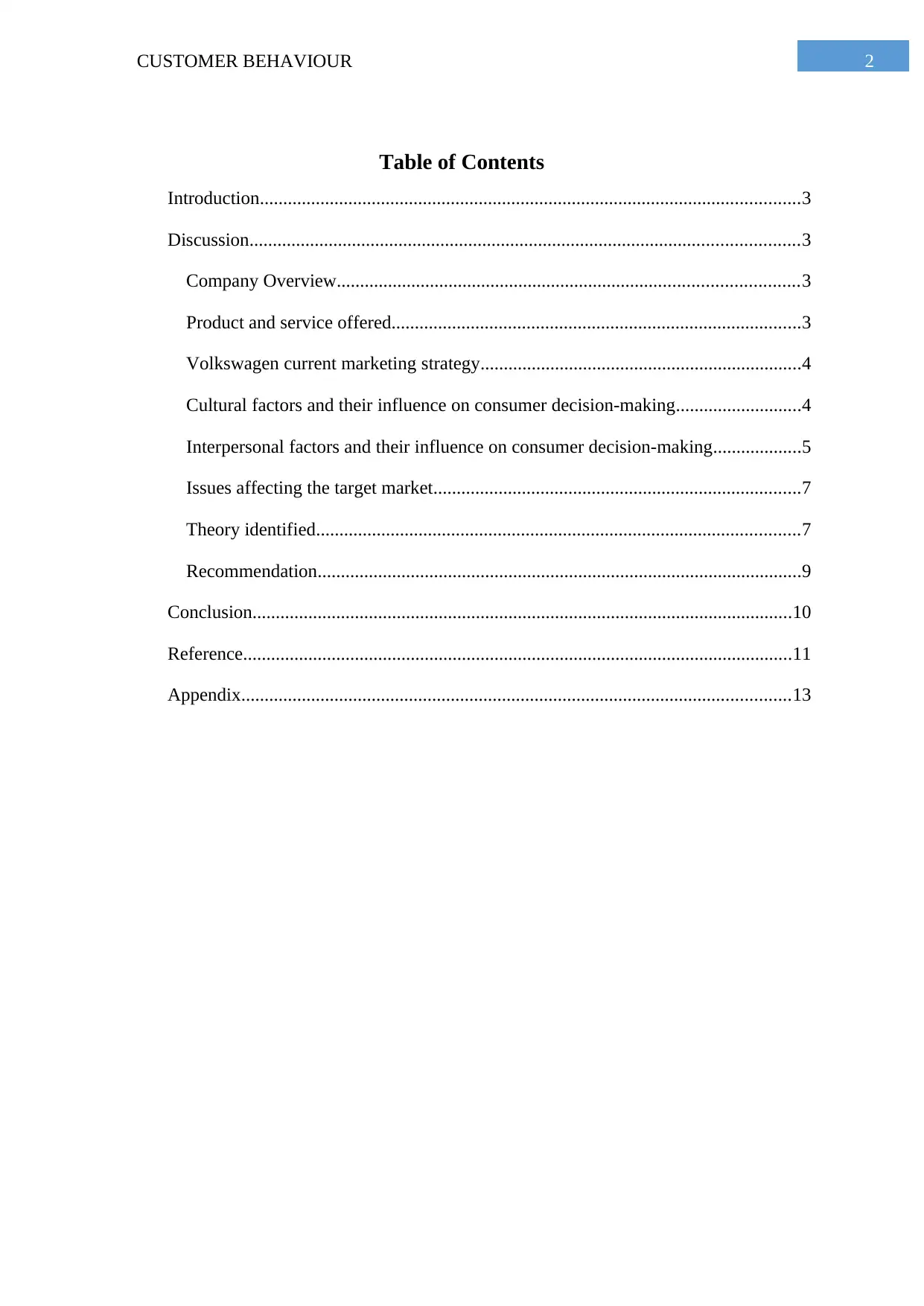
2CUSTOMER BEHAVIOUR
Table of Contents
Introduction....................................................................................................................3
Discussion......................................................................................................................3
Company Overview...................................................................................................3
Product and service offered........................................................................................3
Volkswagen current marketing strategy.....................................................................4
Cultural factors and their influence on consumer decision-making...........................4
Interpersonal factors and their influence on consumer decision-making...................5
Issues affecting the target market...............................................................................7
Theory identified........................................................................................................7
Recommendation........................................................................................................9
Conclusion....................................................................................................................10
Reference......................................................................................................................11
Appendix......................................................................................................................13
Table of Contents
Introduction....................................................................................................................3
Discussion......................................................................................................................3
Company Overview...................................................................................................3
Product and service offered........................................................................................3
Volkswagen current marketing strategy.....................................................................4
Cultural factors and their influence on consumer decision-making...........................4
Interpersonal factors and their influence on consumer decision-making...................5
Issues affecting the target market...............................................................................7
Theory identified........................................................................................................7
Recommendation........................................................................................................9
Conclusion....................................................................................................................10
Reference......................................................................................................................11
Appendix......................................................................................................................13
⊘ This is a preview!⊘
Do you want full access?
Subscribe today to unlock all pages.

Trusted by 1+ million students worldwide
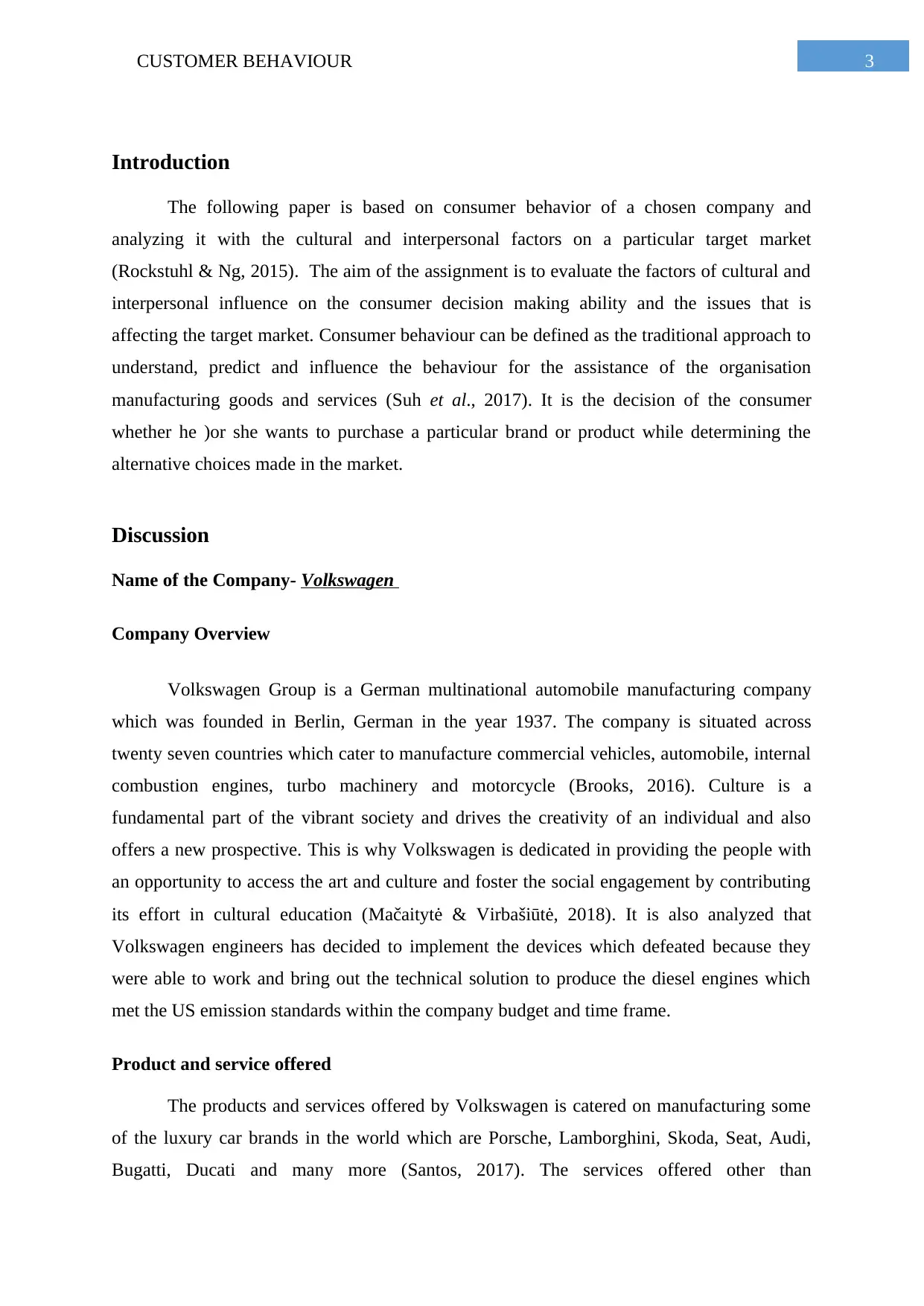
3CUSTOMER BEHAVIOUR
Introduction
The following paper is based on consumer behavior of a chosen company and
analyzing it with the cultural and interpersonal factors on a particular target market
(Rockstuhl & Ng, 2015). The aim of the assignment is to evaluate the factors of cultural and
interpersonal influence on the consumer decision making ability and the issues that is
affecting the target market. Consumer behaviour can be defined as the traditional approach to
understand, predict and influence the behaviour for the assistance of the organisation
manufacturing goods and services (Suh et al., 2017). It is the decision of the consumer
whether he )or she wants to purchase a particular brand or product while determining the
alternative choices made in the market.
Discussion
Name of the Company- Volkswagen
Company Overview
Volkswagen Group is a German multinational automobile manufacturing company
which was founded in Berlin, German in the year 1937. The company is situated across
twenty seven countries which cater to manufacture commercial vehicles, automobile, internal
combustion engines, turbo machinery and motorcycle (Brooks, 2016). Culture is a
fundamental part of the vibrant society and drives the creativity of an individual and also
offers a new prospective. This is why Volkswagen is dedicated in providing the people with
an opportunity to access the art and culture and foster the social engagement by contributing
its effort in cultural education (Mačaitytė & Virbašiūtė, 2018). It is also analyzed that
Volkswagen engineers has decided to implement the devices which defeated because they
were able to work and bring out the technical solution to produce the diesel engines which
met the US emission standards within the company budget and time frame.
Product and service offered
The products and services offered by Volkswagen is catered on manufacturing some
of the luxury car brands in the world which are Porsche, Lamborghini, Skoda, Seat, Audi,
Bugatti, Ducati and many more (Santos, 2017). The services offered other than
Introduction
The following paper is based on consumer behavior of a chosen company and
analyzing it with the cultural and interpersonal factors on a particular target market
(Rockstuhl & Ng, 2015). The aim of the assignment is to evaluate the factors of cultural and
interpersonal influence on the consumer decision making ability and the issues that is
affecting the target market. Consumer behaviour can be defined as the traditional approach to
understand, predict and influence the behaviour for the assistance of the organisation
manufacturing goods and services (Suh et al., 2017). It is the decision of the consumer
whether he )or she wants to purchase a particular brand or product while determining the
alternative choices made in the market.
Discussion
Name of the Company- Volkswagen
Company Overview
Volkswagen Group is a German multinational automobile manufacturing company
which was founded in Berlin, German in the year 1937. The company is situated across
twenty seven countries which cater to manufacture commercial vehicles, automobile, internal
combustion engines, turbo machinery and motorcycle (Brooks, 2016). Culture is a
fundamental part of the vibrant society and drives the creativity of an individual and also
offers a new prospective. This is why Volkswagen is dedicated in providing the people with
an opportunity to access the art and culture and foster the social engagement by contributing
its effort in cultural education (Mačaitytė & Virbašiūtė, 2018). It is also analyzed that
Volkswagen engineers has decided to implement the devices which defeated because they
were able to work and bring out the technical solution to produce the diesel engines which
met the US emission standards within the company budget and time frame.
Product and service offered
The products and services offered by Volkswagen is catered on manufacturing some
of the luxury car brands in the world which are Porsche, Lamborghini, Skoda, Seat, Audi,
Bugatti, Ducati and many more (Santos, 2017). The services offered other than
Paraphrase This Document
Need a fresh take? Get an instant paraphrase of this document with our AI Paraphraser
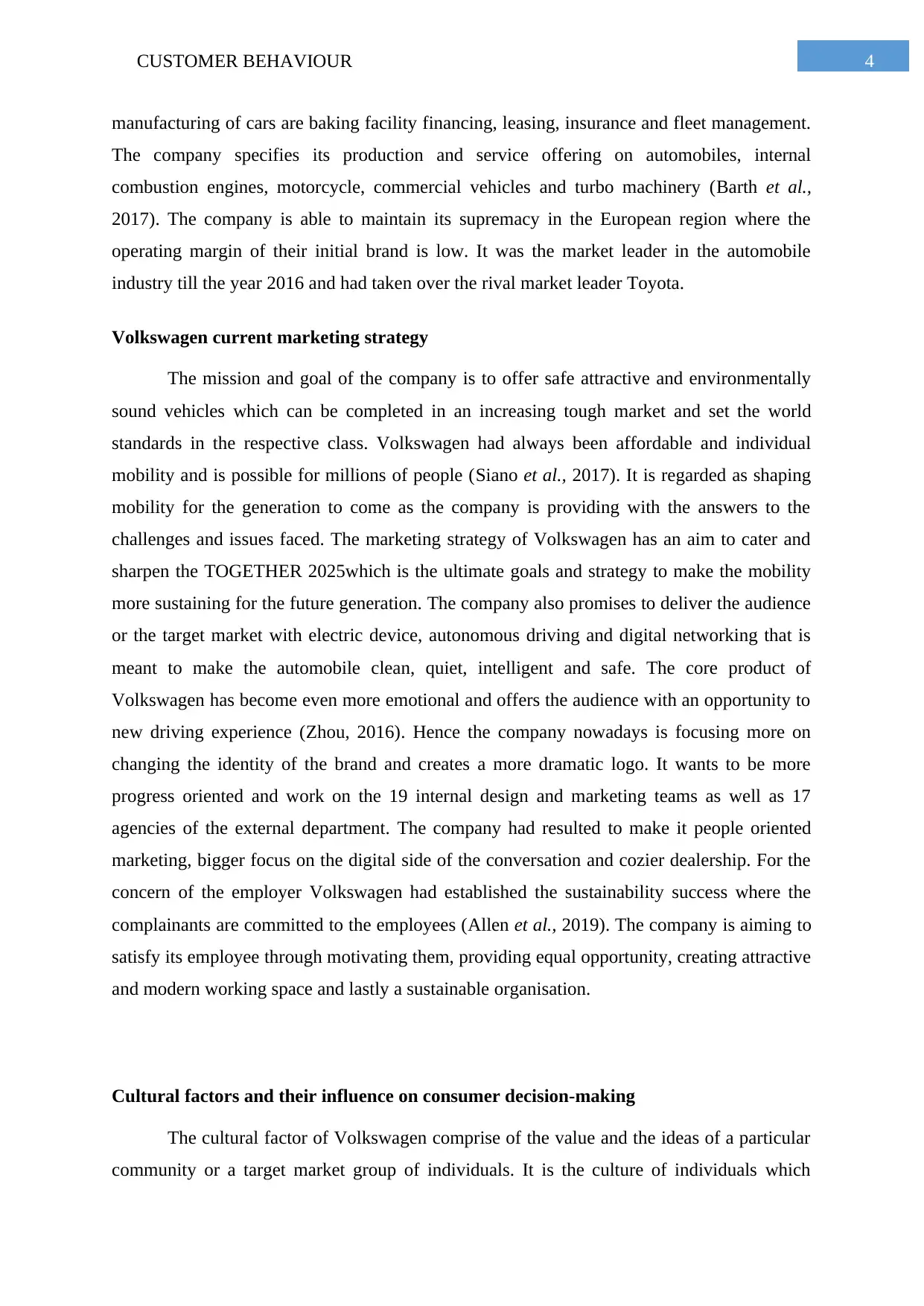
4CUSTOMER BEHAVIOUR
manufacturing of cars are baking facility financing, leasing, insurance and fleet management.
The company specifies its production and service offering on automobiles, internal
combustion engines, motorcycle, commercial vehicles and turbo machinery (Barth et al.,
2017). The company is able to maintain its supremacy in the European region where the
operating margin of their initial brand is low. It was the market leader in the automobile
industry till the year 2016 and had taken over the rival market leader Toyota.
Volkswagen current marketing strategy
The mission and goal of the company is to offer safe attractive and environmentally
sound vehicles which can be completed in an increasing tough market and set the world
standards in the respective class. Volkswagen had always been affordable and individual
mobility and is possible for millions of people (Siano et al., 2017). It is regarded as shaping
mobility for the generation to come as the company is providing with the answers to the
challenges and issues faced. The marketing strategy of Volkswagen has an aim to cater and
sharpen the TOGETHER 2025which is the ultimate goals and strategy to make the mobility
more sustaining for the future generation. The company also promises to deliver the audience
or the target market with electric device, autonomous driving and digital networking that is
meant to make the automobile clean, quiet, intelligent and safe. The core product of
Volkswagen has become even more emotional and offers the audience with an opportunity to
new driving experience (Zhou, 2016). Hence the company nowadays is focusing more on
changing the identity of the brand and creates a more dramatic logo. It wants to be more
progress oriented and work on the 19 internal design and marketing teams as well as 17
agencies of the external department. The company had resulted to make it people oriented
marketing, bigger focus on the digital side of the conversation and cozier dealership. For the
concern of the employer Volkswagen had established the sustainability success where the
complainants are committed to the employees (Allen et al., 2019). The company is aiming to
satisfy its employee through motivating them, providing equal opportunity, creating attractive
and modern working space and lastly a sustainable organisation.
Cultural factors and their influence on consumer decision-making
The cultural factor of Volkswagen comprise of the value and the ideas of a particular
community or a target market group of individuals. It is the culture of individuals which
manufacturing of cars are baking facility financing, leasing, insurance and fleet management.
The company specifies its production and service offering on automobiles, internal
combustion engines, motorcycle, commercial vehicles and turbo machinery (Barth et al.,
2017). The company is able to maintain its supremacy in the European region where the
operating margin of their initial brand is low. It was the market leader in the automobile
industry till the year 2016 and had taken over the rival market leader Toyota.
Volkswagen current marketing strategy
The mission and goal of the company is to offer safe attractive and environmentally
sound vehicles which can be completed in an increasing tough market and set the world
standards in the respective class. Volkswagen had always been affordable and individual
mobility and is possible for millions of people (Siano et al., 2017). It is regarded as shaping
mobility for the generation to come as the company is providing with the answers to the
challenges and issues faced. The marketing strategy of Volkswagen has an aim to cater and
sharpen the TOGETHER 2025which is the ultimate goals and strategy to make the mobility
more sustaining for the future generation. The company also promises to deliver the audience
or the target market with electric device, autonomous driving and digital networking that is
meant to make the automobile clean, quiet, intelligent and safe. The core product of
Volkswagen has become even more emotional and offers the audience with an opportunity to
new driving experience (Zhou, 2016). Hence the company nowadays is focusing more on
changing the identity of the brand and creates a more dramatic logo. It wants to be more
progress oriented and work on the 19 internal design and marketing teams as well as 17
agencies of the external department. The company had resulted to make it people oriented
marketing, bigger focus on the digital side of the conversation and cozier dealership. For the
concern of the employer Volkswagen had established the sustainability success where the
complainants are committed to the employees (Allen et al., 2019). The company is aiming to
satisfy its employee through motivating them, providing equal opportunity, creating attractive
and modern working space and lastly a sustainable organisation.
Cultural factors and their influence on consumer decision-making
The cultural factor of Volkswagen comprise of the value and the ideas of a particular
community or a target market group of individuals. It is the culture of individuals which
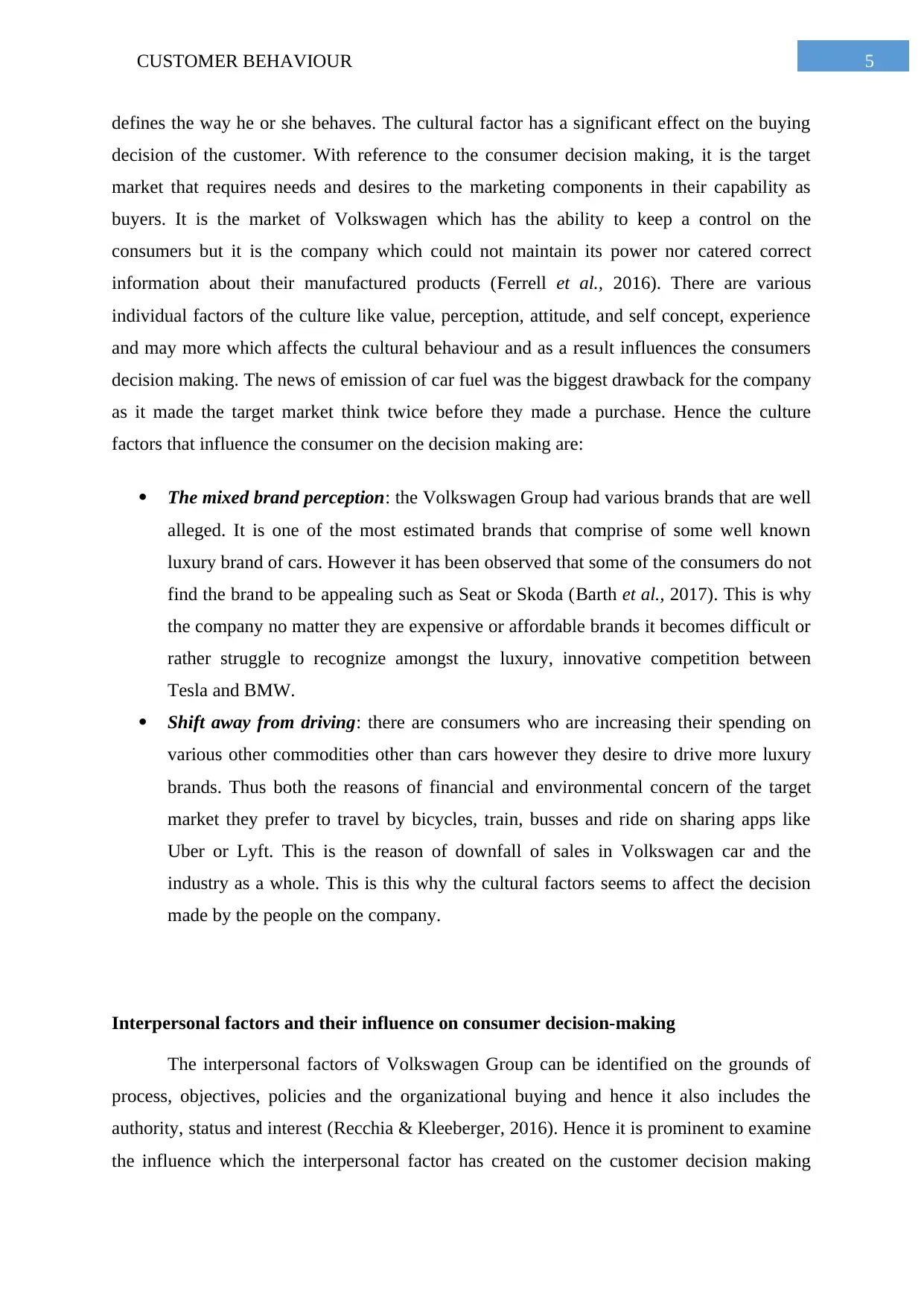
5CUSTOMER BEHAVIOUR
defines the way he or she behaves. The cultural factor has a significant effect on the buying
decision of the customer. With reference to the consumer decision making, it is the target
market that requires needs and desires to the marketing components in their capability as
buyers. It is the market of Volkswagen which has the ability to keep a control on the
consumers but it is the company which could not maintain its power nor catered correct
information about their manufactured products (Ferrell et al., 2016). There are various
individual factors of the culture like value, perception, attitude, and self concept, experience
and may more which affects the cultural behaviour and as a result influences the consumers
decision making. The news of emission of car fuel was the biggest drawback for the company
as it made the target market think twice before they made a purchase. Hence the culture
factors that influence the consumer on the decision making are:
The mixed brand perception: the Volkswagen Group had various brands that are well
alleged. It is one of the most estimated brands that comprise of some well known
luxury brand of cars. However it has been observed that some of the consumers do not
find the brand to be appealing such as Seat or Skoda (Barth et al., 2017). This is why
the company no matter they are expensive or affordable brands it becomes difficult or
rather struggle to recognize amongst the luxury, innovative competition between
Tesla and BMW.
Shift away from driving: there are consumers who are increasing their spending on
various other commodities other than cars however they desire to drive more luxury
brands. Thus both the reasons of financial and environmental concern of the target
market they prefer to travel by bicycles, train, busses and ride on sharing apps like
Uber or Lyft. This is the reason of downfall of sales in Volkswagen car and the
industry as a whole. This is this why the cultural factors seems to affect the decision
made by the people on the company.
Interpersonal factors and their influence on consumer decision-making
The interpersonal factors of Volkswagen Group can be identified on the grounds of
process, objectives, policies and the organizational buying and hence it also includes the
authority, status and interest (Recchia & Kleeberger, 2016). Hence it is prominent to examine
the influence which the interpersonal factor has created on the customer decision making
defines the way he or she behaves. The cultural factor has a significant effect on the buying
decision of the customer. With reference to the consumer decision making, it is the target
market that requires needs and desires to the marketing components in their capability as
buyers. It is the market of Volkswagen which has the ability to keep a control on the
consumers but it is the company which could not maintain its power nor catered correct
information about their manufactured products (Ferrell et al., 2016). There are various
individual factors of the culture like value, perception, attitude, and self concept, experience
and may more which affects the cultural behaviour and as a result influences the consumers
decision making. The news of emission of car fuel was the biggest drawback for the company
as it made the target market think twice before they made a purchase. Hence the culture
factors that influence the consumer on the decision making are:
The mixed brand perception: the Volkswagen Group had various brands that are well
alleged. It is one of the most estimated brands that comprise of some well known
luxury brand of cars. However it has been observed that some of the consumers do not
find the brand to be appealing such as Seat or Skoda (Barth et al., 2017). This is why
the company no matter they are expensive or affordable brands it becomes difficult or
rather struggle to recognize amongst the luxury, innovative competition between
Tesla and BMW.
Shift away from driving: there are consumers who are increasing their spending on
various other commodities other than cars however they desire to drive more luxury
brands. Thus both the reasons of financial and environmental concern of the target
market they prefer to travel by bicycles, train, busses and ride on sharing apps like
Uber or Lyft. This is the reason of downfall of sales in Volkswagen car and the
industry as a whole. This is this why the cultural factors seems to affect the decision
made by the people on the company.
Interpersonal factors and their influence on consumer decision-making
The interpersonal factors of Volkswagen Group can be identified on the grounds of
process, objectives, policies and the organizational buying and hence it also includes the
authority, status and interest (Recchia & Kleeberger, 2016). Hence it is prominent to examine
the influence which the interpersonal factor has created on the customer decision making
⊘ This is a preview!⊘
Do you want full access?
Subscribe today to unlock all pages.

Trusted by 1+ million students worldwide
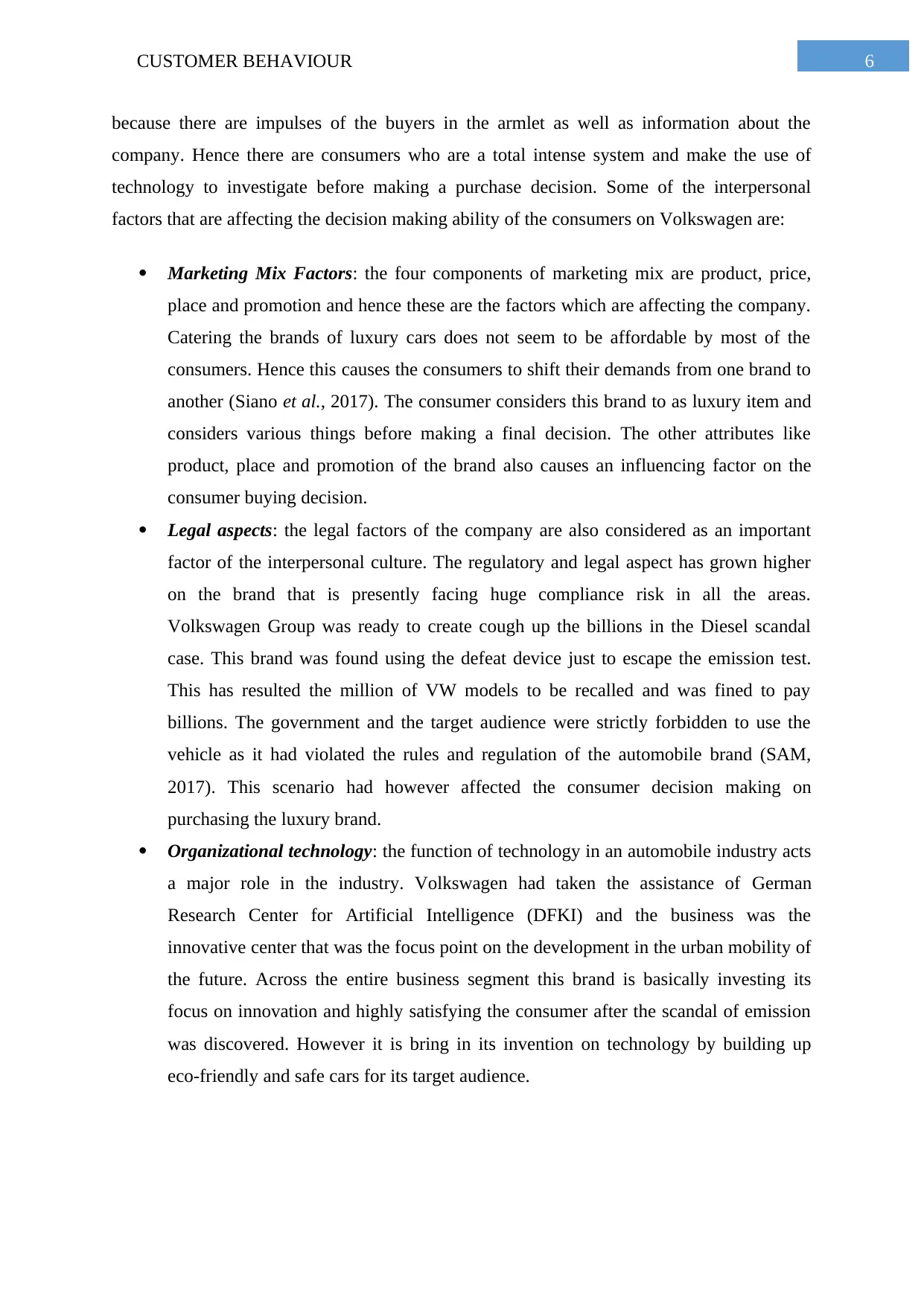
6CUSTOMER BEHAVIOUR
because there are impulses of the buyers in the armlet as well as information about the
company. Hence there are consumers who are a total intense system and make the use of
technology to investigate before making a purchase decision. Some of the interpersonal
factors that are affecting the decision making ability of the consumers on Volkswagen are:
Marketing Mix Factors: the four components of marketing mix are product, price,
place and promotion and hence these are the factors which are affecting the company.
Catering the brands of luxury cars does not seem to be affordable by most of the
consumers. Hence this causes the consumers to shift their demands from one brand to
another (Siano et al., 2017). The consumer considers this brand to as luxury item and
considers various things before making a final decision. The other attributes like
product, place and promotion of the brand also causes an influencing factor on the
consumer buying decision.
Legal aspects: the legal factors of the company are also considered as an important
factor of the interpersonal culture. The regulatory and legal aspect has grown higher
on the brand that is presently facing huge compliance risk in all the areas.
Volkswagen Group was ready to create cough up the billions in the Diesel scandal
case. This brand was found using the defeat device just to escape the emission test.
This has resulted the million of VW models to be recalled and was fined to pay
billions. The government and the target audience were strictly forbidden to use the
vehicle as it had violated the rules and regulation of the automobile brand (SAM,
2017). This scenario had however affected the consumer decision making on
purchasing the luxury brand.
Organizational technology: the function of technology in an automobile industry acts
a major role in the industry. Volkswagen had taken the assistance of German
Research Center for Artificial Intelligence (DFKI) and the business was the
innovative center that was the focus point on the development in the urban mobility of
the future. Across the entire business segment this brand is basically investing its
focus on innovation and highly satisfying the consumer after the scandal of emission
was discovered. However it is bring in its invention on technology by building up
eco-friendly and safe cars for its target audience.
because there are impulses of the buyers in the armlet as well as information about the
company. Hence there are consumers who are a total intense system and make the use of
technology to investigate before making a purchase decision. Some of the interpersonal
factors that are affecting the decision making ability of the consumers on Volkswagen are:
Marketing Mix Factors: the four components of marketing mix are product, price,
place and promotion and hence these are the factors which are affecting the company.
Catering the brands of luxury cars does not seem to be affordable by most of the
consumers. Hence this causes the consumers to shift their demands from one brand to
another (Siano et al., 2017). The consumer considers this brand to as luxury item and
considers various things before making a final decision. The other attributes like
product, place and promotion of the brand also causes an influencing factor on the
consumer buying decision.
Legal aspects: the legal factors of the company are also considered as an important
factor of the interpersonal culture. The regulatory and legal aspect has grown higher
on the brand that is presently facing huge compliance risk in all the areas.
Volkswagen Group was ready to create cough up the billions in the Diesel scandal
case. This brand was found using the defeat device just to escape the emission test.
This has resulted the million of VW models to be recalled and was fined to pay
billions. The government and the target audience were strictly forbidden to use the
vehicle as it had violated the rules and regulation of the automobile brand (SAM,
2017). This scenario had however affected the consumer decision making on
purchasing the luxury brand.
Organizational technology: the function of technology in an automobile industry acts
a major role in the industry. Volkswagen had taken the assistance of German
Research Center for Artificial Intelligence (DFKI) and the business was the
innovative center that was the focus point on the development in the urban mobility of
the future. Across the entire business segment this brand is basically investing its
focus on innovation and highly satisfying the consumer after the scandal of emission
was discovered. However it is bring in its invention on technology by building up
eco-friendly and safe cars for its target audience.
Paraphrase This Document
Need a fresh take? Get an instant paraphrase of this document with our AI Paraphraser
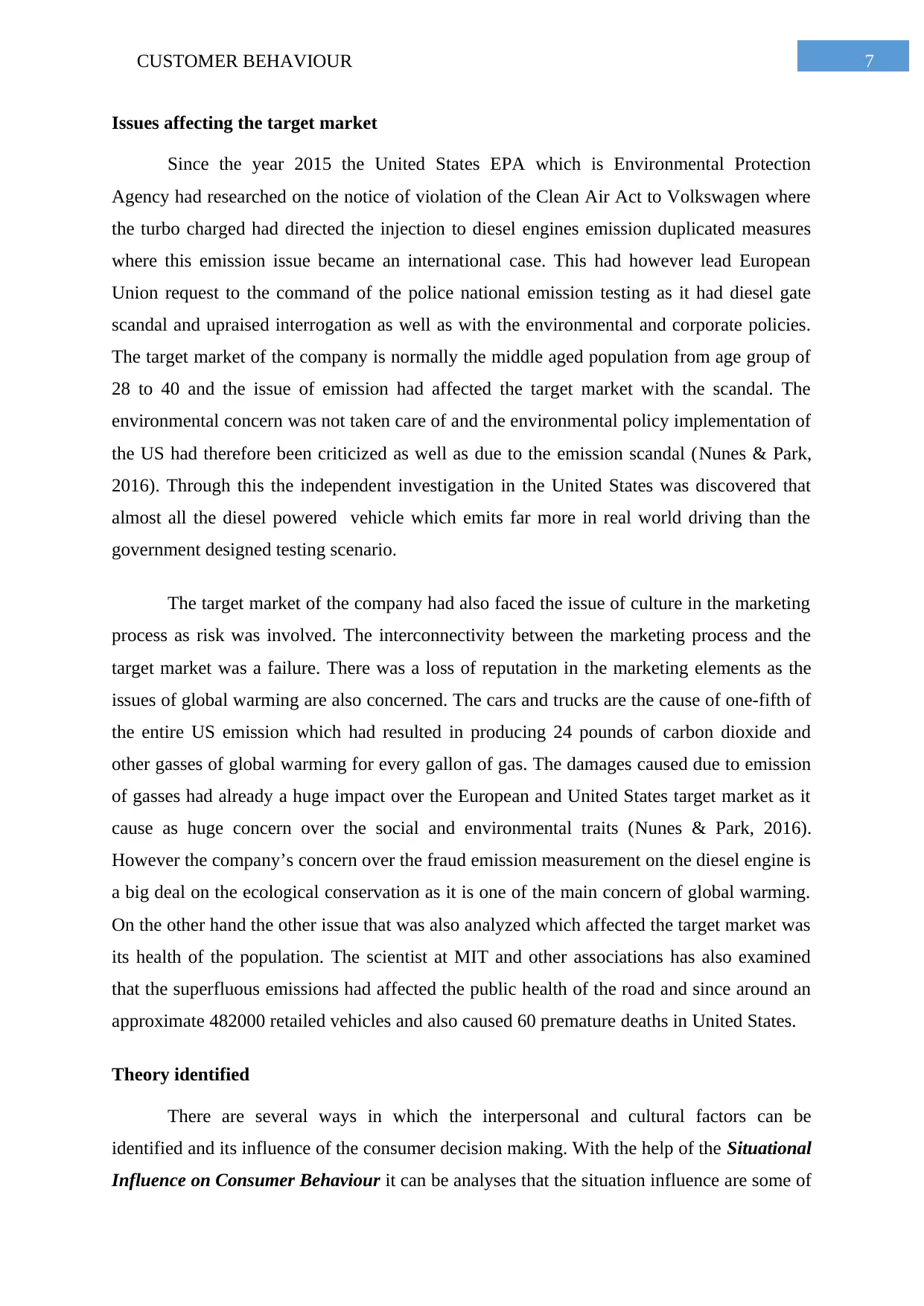
7CUSTOMER BEHAVIOUR
Issues affecting the target market
Since the year 2015 the United States EPA which is Environmental Protection
Agency had researched on the notice of violation of the Clean Air Act to Volkswagen where
the turbo charged had directed the injection to diesel engines emission duplicated measures
where this emission issue became an international case. This had however lead European
Union request to the command of the police national emission testing as it had diesel gate
scandal and upraised interrogation as well as with the environmental and corporate policies.
The target market of the company is normally the middle aged population from age group of
28 to 40 and the issue of emission had affected the target market with the scandal. The
environmental concern was not taken care of and the environmental policy implementation of
the US had therefore been criticized as well as due to the emission scandal (Nunes & Park,
2016). Through this the independent investigation in the United States was discovered that
almost all the diesel powered vehicle which emits far more in real world driving than the
government designed testing scenario.
The target market of the company had also faced the issue of culture in the marketing
process as risk was involved. The interconnectivity between the marketing process and the
target market was a failure. There was a loss of reputation in the marketing elements as the
issues of global warming are also concerned. The cars and trucks are the cause of one-fifth of
the entire US emission which had resulted in producing 24 pounds of carbon dioxide and
other gasses of global warming for every gallon of gas. The damages caused due to emission
of gasses had already a huge impact over the European and United States target market as it
cause as huge concern over the social and environmental traits (Nunes & Park, 2016).
However the company’s concern over the fraud emission measurement on the diesel engine is
a big deal on the ecological conservation as it is one of the main concern of global warming.
On the other hand the other issue that was also analyzed which affected the target market was
its health of the population. The scientist at MIT and other associations has also examined
that the superfluous emissions had affected the public health of the road and since around an
approximate 482000 retailed vehicles and also caused 60 premature deaths in United States.
Theory identified
There are several ways in which the interpersonal and cultural factors can be
identified and its influence of the consumer decision making. With the help of the Situational
Influence on Consumer Behaviour it can be analyses that the situation influence are some of
Issues affecting the target market
Since the year 2015 the United States EPA which is Environmental Protection
Agency had researched on the notice of violation of the Clean Air Act to Volkswagen where
the turbo charged had directed the injection to diesel engines emission duplicated measures
where this emission issue became an international case. This had however lead European
Union request to the command of the police national emission testing as it had diesel gate
scandal and upraised interrogation as well as with the environmental and corporate policies.
The target market of the company is normally the middle aged population from age group of
28 to 40 and the issue of emission had affected the target market with the scandal. The
environmental concern was not taken care of and the environmental policy implementation of
the US had therefore been criticized as well as due to the emission scandal (Nunes & Park,
2016). Through this the independent investigation in the United States was discovered that
almost all the diesel powered vehicle which emits far more in real world driving than the
government designed testing scenario.
The target market of the company had also faced the issue of culture in the marketing
process as risk was involved. The interconnectivity between the marketing process and the
target market was a failure. There was a loss of reputation in the marketing elements as the
issues of global warming are also concerned. The cars and trucks are the cause of one-fifth of
the entire US emission which had resulted in producing 24 pounds of carbon dioxide and
other gasses of global warming for every gallon of gas. The damages caused due to emission
of gasses had already a huge impact over the European and United States target market as it
cause as huge concern over the social and environmental traits (Nunes & Park, 2016).
However the company’s concern over the fraud emission measurement on the diesel engine is
a big deal on the ecological conservation as it is one of the main concern of global warming.
On the other hand the other issue that was also analyzed which affected the target market was
its health of the population. The scientist at MIT and other associations has also examined
that the superfluous emissions had affected the public health of the road and since around an
approximate 482000 retailed vehicles and also caused 60 premature deaths in United States.
Theory identified
There are several ways in which the interpersonal and cultural factors can be
identified and its influence of the consumer decision making. With the help of the Situational
Influence on Consumer Behaviour it can be analyses that the situation influence are some of
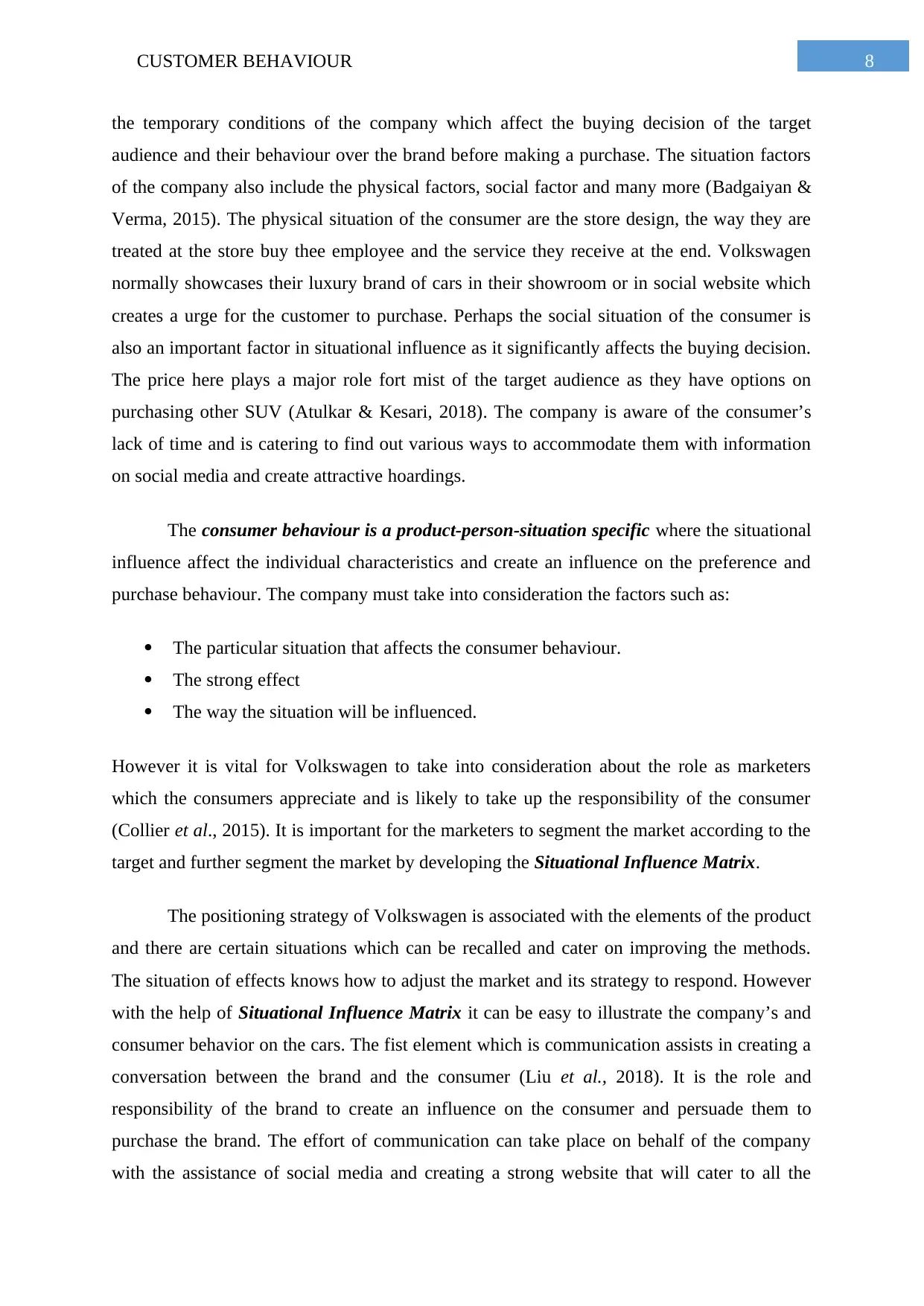
8CUSTOMER BEHAVIOUR
the temporary conditions of the company which affect the buying decision of the target
audience and their behaviour over the brand before making a purchase. The situation factors
of the company also include the physical factors, social factor and many more (Badgaiyan &
Verma, 2015). The physical situation of the consumer are the store design, the way they are
treated at the store buy thee employee and the service they receive at the end. Volkswagen
normally showcases their luxury brand of cars in their showroom or in social website which
creates a urge for the customer to purchase. Perhaps the social situation of the consumer is
also an important factor in situational influence as it significantly affects the buying decision.
The price here plays a major role fort mist of the target audience as they have options on
purchasing other SUV (Atulkar & Kesari, 2018). The company is aware of the consumer’s
lack of time and is catering to find out various ways to accommodate them with information
on social media and create attractive hoardings.
The consumer behaviour is a product-person-situation specific where the situational
influence affect the individual characteristics and create an influence on the preference and
purchase behaviour. The company must take into consideration the factors such as:
The particular situation that affects the consumer behaviour.
The strong effect
The way the situation will be influenced.
However it is vital for Volkswagen to take into consideration about the role as marketers
which the consumers appreciate and is likely to take up the responsibility of the consumer
(Collier et al., 2015). It is important for the marketers to segment the market according to the
target and further segment the market by developing the Situational Influence Matrix.
The positioning strategy of Volkswagen is associated with the elements of the product
and there are certain situations which can be recalled and cater on improving the methods.
The situation of effects knows how to adjust the market and its strategy to respond. However
with the help of Situational Influence Matrix it can be easy to illustrate the company’s and
consumer behavior on the cars. The fist element which is communication assists in creating a
conversation between the brand and the consumer (Liu et al., 2018). It is the role and
responsibility of the brand to create an influence on the consumer and persuade them to
purchase the brand. The effort of communication can take place on behalf of the company
with the assistance of social media and creating a strong website that will cater to all the
the temporary conditions of the company which affect the buying decision of the target
audience and their behaviour over the brand before making a purchase. The situation factors
of the company also include the physical factors, social factor and many more (Badgaiyan &
Verma, 2015). The physical situation of the consumer are the store design, the way they are
treated at the store buy thee employee and the service they receive at the end. Volkswagen
normally showcases their luxury brand of cars in their showroom or in social website which
creates a urge for the customer to purchase. Perhaps the social situation of the consumer is
also an important factor in situational influence as it significantly affects the buying decision.
The price here plays a major role fort mist of the target audience as they have options on
purchasing other SUV (Atulkar & Kesari, 2018). The company is aware of the consumer’s
lack of time and is catering to find out various ways to accommodate them with information
on social media and create attractive hoardings.
The consumer behaviour is a product-person-situation specific where the situational
influence affect the individual characteristics and create an influence on the preference and
purchase behaviour. The company must take into consideration the factors such as:
The particular situation that affects the consumer behaviour.
The strong effect
The way the situation will be influenced.
However it is vital for Volkswagen to take into consideration about the role as marketers
which the consumers appreciate and is likely to take up the responsibility of the consumer
(Collier et al., 2015). It is important for the marketers to segment the market according to the
target and further segment the market by developing the Situational Influence Matrix.
The positioning strategy of Volkswagen is associated with the elements of the product
and there are certain situations which can be recalled and cater on improving the methods.
The situation of effects knows how to adjust the market and its strategy to respond. However
with the help of Situational Influence Matrix it can be easy to illustrate the company’s and
consumer behavior on the cars. The fist element which is communication assists in creating a
conversation between the brand and the consumer (Liu et al., 2018). It is the role and
responsibility of the brand to create an influence on the consumer and persuade them to
purchase the brand. The effort of communication can take place on behalf of the company
with the assistance of social media and creating a strong website that will cater to all the
⊘ This is a preview!⊘
Do you want full access?
Subscribe today to unlock all pages.

Trusted by 1+ million students worldwide
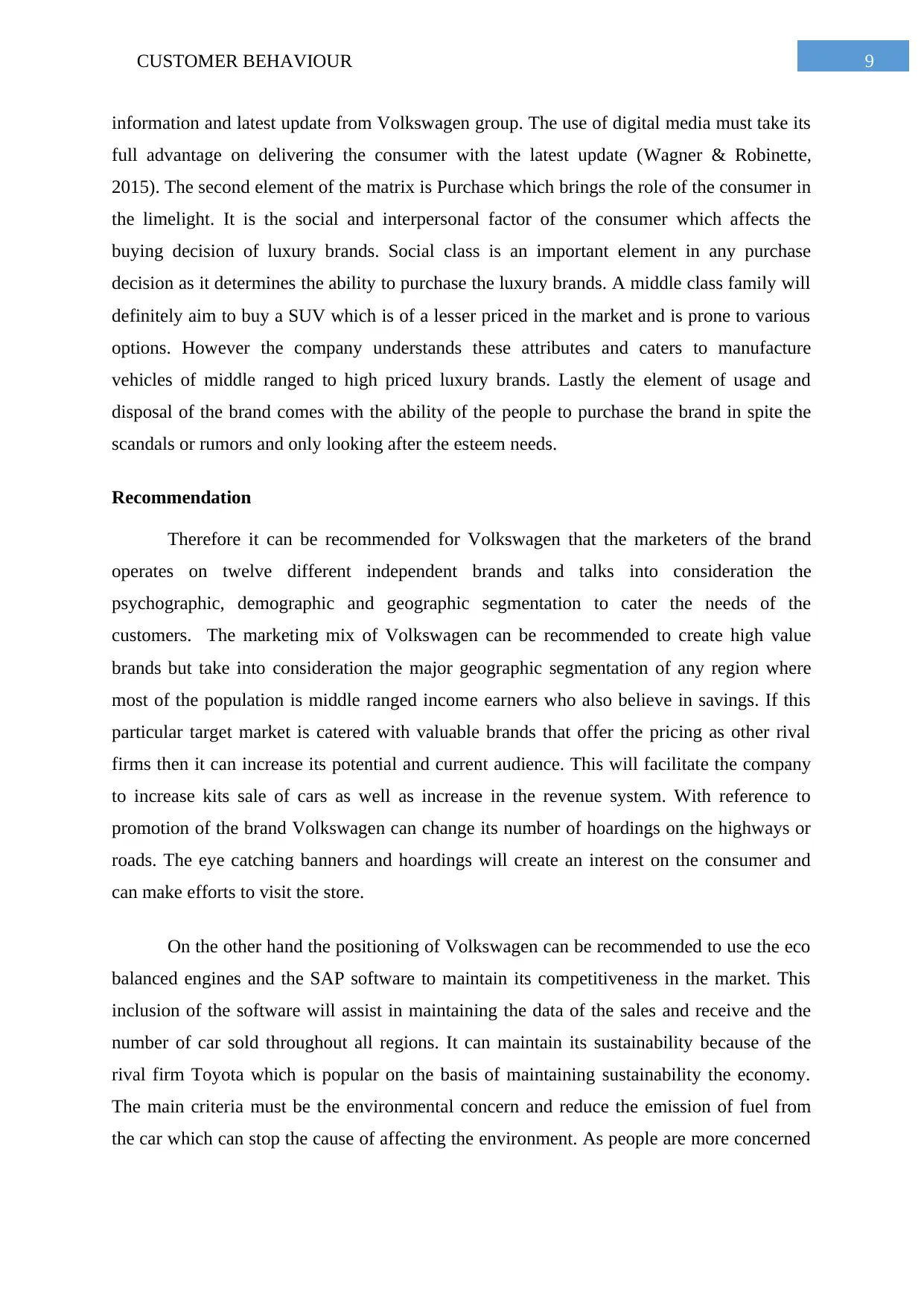
9CUSTOMER BEHAVIOUR
information and latest update from Volkswagen group. The use of digital media must take its
full advantage on delivering the consumer with the latest update (Wagner & Robinette,
2015). The second element of the matrix is Purchase which brings the role of the consumer in
the limelight. It is the social and interpersonal factor of the consumer which affects the
buying decision of luxury brands. Social class is an important element in any purchase
decision as it determines the ability to purchase the luxury brands. A middle class family will
definitely aim to buy a SUV which is of a lesser priced in the market and is prone to various
options. However the company understands these attributes and caters to manufacture
vehicles of middle ranged to high priced luxury brands. Lastly the element of usage and
disposal of the brand comes with the ability of the people to purchase the brand in spite the
scandals or rumors and only looking after the esteem needs.
Recommendation
Therefore it can be recommended for Volkswagen that the marketers of the brand
operates on twelve different independent brands and talks into consideration the
psychographic, demographic and geographic segmentation to cater the needs of the
customers. The marketing mix of Volkswagen can be recommended to create high value
brands but take into consideration the major geographic segmentation of any region where
most of the population is middle ranged income earners who also believe in savings. If this
particular target market is catered with valuable brands that offer the pricing as other rival
firms then it can increase its potential and current audience. This will facilitate the company
to increase kits sale of cars as well as increase in the revenue system. With reference to
promotion of the brand Volkswagen can change its number of hoardings on the highways or
roads. The eye catching banners and hoardings will create an interest on the consumer and
can make efforts to visit the store.
On the other hand the positioning of Volkswagen can be recommended to use the eco
balanced engines and the SAP software to maintain its competitiveness in the market. This
inclusion of the software will assist in maintaining the data of the sales and receive and the
number of car sold throughout all regions. It can maintain its sustainability because of the
rival firm Toyota which is popular on the basis of maintaining sustainability the economy.
The main criteria must be the environmental concern and reduce the emission of fuel from
the car which can stop the cause of affecting the environment. As people are more concerned
information and latest update from Volkswagen group. The use of digital media must take its
full advantage on delivering the consumer with the latest update (Wagner & Robinette,
2015). The second element of the matrix is Purchase which brings the role of the consumer in
the limelight. It is the social and interpersonal factor of the consumer which affects the
buying decision of luxury brands. Social class is an important element in any purchase
decision as it determines the ability to purchase the luxury brands. A middle class family will
definitely aim to buy a SUV which is of a lesser priced in the market and is prone to various
options. However the company understands these attributes and caters to manufacture
vehicles of middle ranged to high priced luxury brands. Lastly the element of usage and
disposal of the brand comes with the ability of the people to purchase the brand in spite the
scandals or rumors and only looking after the esteem needs.
Recommendation
Therefore it can be recommended for Volkswagen that the marketers of the brand
operates on twelve different independent brands and talks into consideration the
psychographic, demographic and geographic segmentation to cater the needs of the
customers. The marketing mix of Volkswagen can be recommended to create high value
brands but take into consideration the major geographic segmentation of any region where
most of the population is middle ranged income earners who also believe in savings. If this
particular target market is catered with valuable brands that offer the pricing as other rival
firms then it can increase its potential and current audience. This will facilitate the company
to increase kits sale of cars as well as increase in the revenue system. With reference to
promotion of the brand Volkswagen can change its number of hoardings on the highways or
roads. The eye catching banners and hoardings will create an interest on the consumer and
can make efforts to visit the store.
On the other hand the positioning of Volkswagen can be recommended to use the eco
balanced engines and the SAP software to maintain its competitiveness in the market. This
inclusion of the software will assist in maintaining the data of the sales and receive and the
number of car sold throughout all regions. It can maintain its sustainability because of the
rival firm Toyota which is popular on the basis of maintaining sustainability the economy.
The main criteria must be the environmental concern and reduce the emission of fuel from
the car which can stop the cause of affecting the environment. As people are more concerned
Paraphrase This Document
Need a fresh take? Get an instant paraphrase of this document with our AI Paraphraser
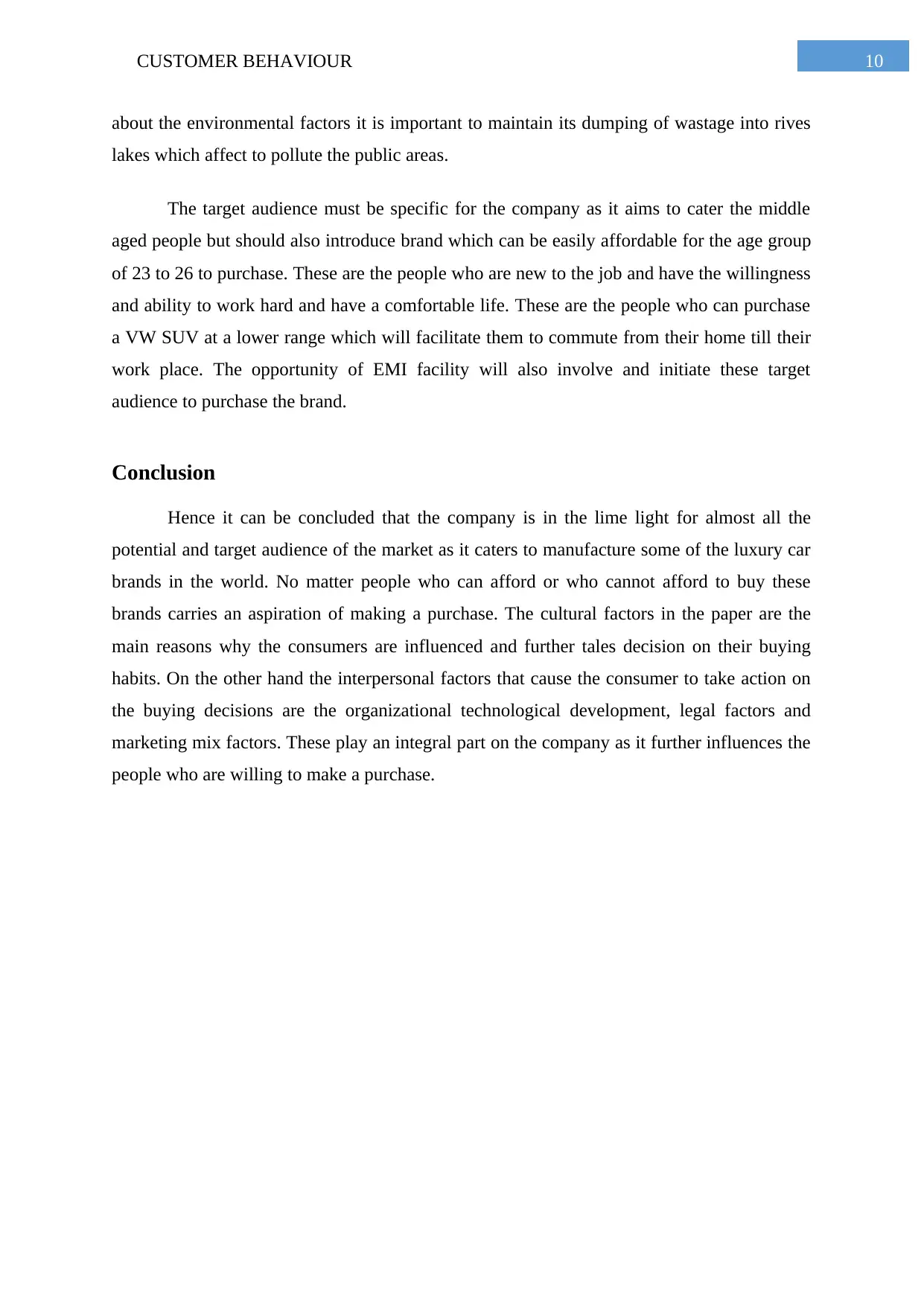
10CUSTOMER BEHAVIOUR
about the environmental factors it is important to maintain its dumping of wastage into rives
lakes which affect to pollute the public areas.
The target audience must be specific for the company as it aims to cater the middle
aged people but should also introduce brand which can be easily affordable for the age group
of 23 to 26 to purchase. These are the people who are new to the job and have the willingness
and ability to work hard and have a comfortable life. These are the people who can purchase
a VW SUV at a lower range which will facilitate them to commute from their home till their
work place. The opportunity of EMI facility will also involve and initiate these target
audience to purchase the brand.
Conclusion
Hence it can be concluded that the company is in the lime light for almost all the
potential and target audience of the market as it caters to manufacture some of the luxury car
brands in the world. No matter people who can afford or who cannot afford to buy these
brands carries an aspiration of making a purchase. The cultural factors in the paper are the
main reasons why the consumers are influenced and further tales decision on their buying
habits. On the other hand the interpersonal factors that cause the consumer to take action on
the buying decisions are the organizational technological development, legal factors and
marketing mix factors. These play an integral part on the company as it further influences the
people who are willing to make a purchase.
about the environmental factors it is important to maintain its dumping of wastage into rives
lakes which affect to pollute the public areas.
The target audience must be specific for the company as it aims to cater the middle
aged people but should also introduce brand which can be easily affordable for the age group
of 23 to 26 to purchase. These are the people who are new to the job and have the willingness
and ability to work hard and have a comfortable life. These are the people who can purchase
a VW SUV at a lower range which will facilitate them to commute from their home till their
work place. The opportunity of EMI facility will also involve and initiate these target
audience to purchase the brand.
Conclusion
Hence it can be concluded that the company is in the lime light for almost all the
potential and target audience of the market as it caters to manufacture some of the luxury car
brands in the world. No matter people who can afford or who cannot afford to buy these
brands carries an aspiration of making a purchase. The cultural factors in the paper are the
main reasons why the consumers are influenced and further tales decision on their buying
habits. On the other hand the interpersonal factors that cause the consumer to take action on
the buying decisions are the organizational technological development, legal factors and
marketing mix factors. These play an integral part on the company as it further influences the
people who are willing to make a purchase.
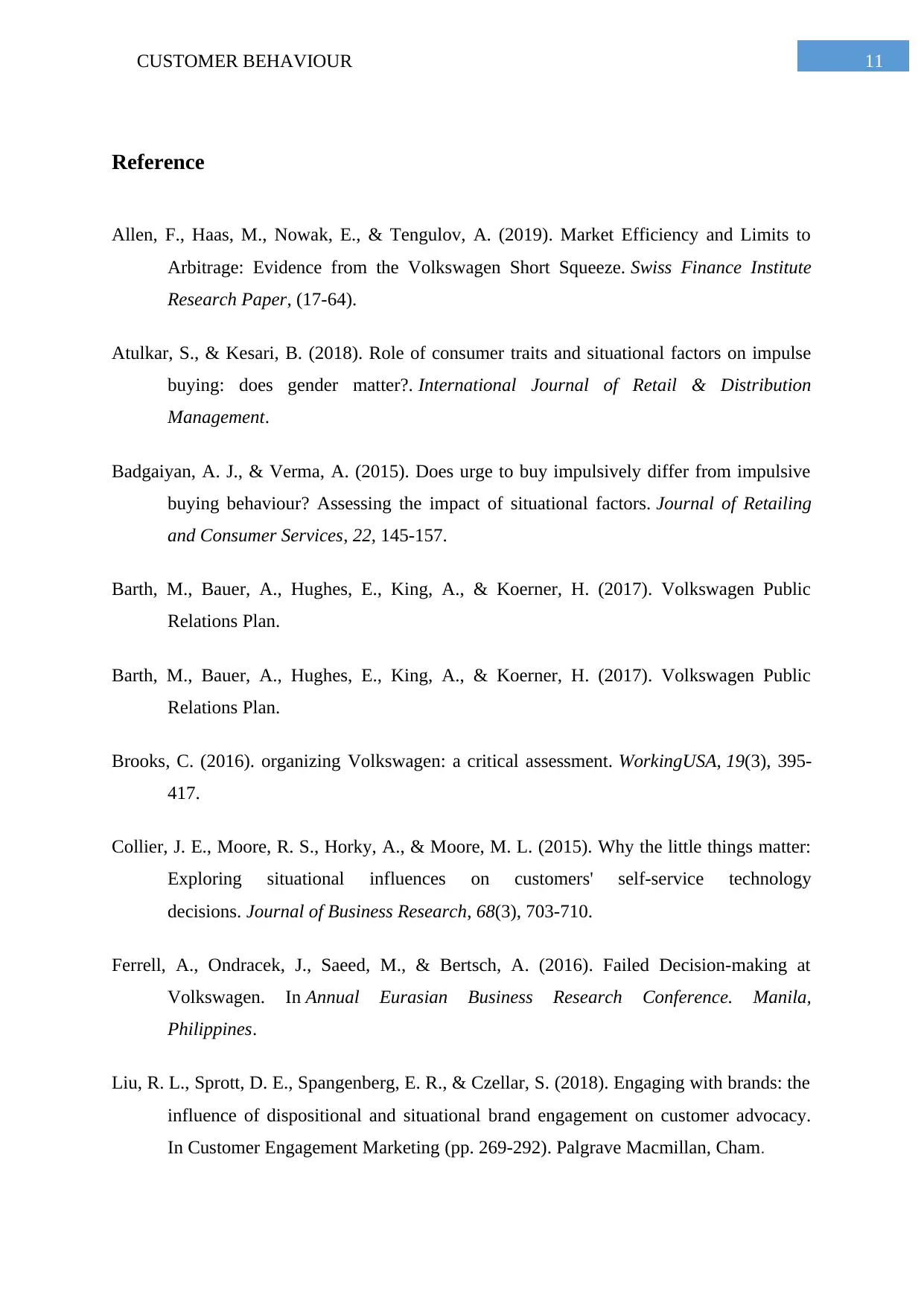
11CUSTOMER BEHAVIOUR
Reference
Allen, F., Haas, M., Nowak, E., & Tengulov, A. (2019). Market Efficiency and Limits to
Arbitrage: Evidence from the Volkswagen Short Squeeze. Swiss Finance Institute
Research Paper, (17-64).
Atulkar, S., & Kesari, B. (2018). Role of consumer traits and situational factors on impulse
buying: does gender matter?. International Journal of Retail & Distribution
Management.
Badgaiyan, A. J., & Verma, A. (2015). Does urge to buy impulsively differ from impulsive
buying behaviour? Assessing the impact of situational factors. Journal of Retailing
and Consumer Services, 22, 145-157.
Barth, M., Bauer, A., Hughes, E., King, A., & Koerner, H. (2017). Volkswagen Public
Relations Plan.
Barth, M., Bauer, A., Hughes, E., King, A., & Koerner, H. (2017). Volkswagen Public
Relations Plan.
Brooks, C. (2016). organizing Volkswagen: a critical assessment. WorkingUSA, 19(3), 395-
417.
Collier, J. E., Moore, R. S., Horky, A., & Moore, M. L. (2015). Why the little things matter:
Exploring situational influences on customers' self-service technology
decisions. Journal of Business Research, 68(3), 703-710.
Ferrell, A., Ondracek, J., Saeed, M., & Bertsch, A. (2016). Failed Decision-making at
Volkswagen. In Annual Eurasian Business Research Conference. Manila,
Philippines.
Liu, R. L., Sprott, D. E., Spangenberg, E. R., & Czellar, S. (2018). Engaging with brands: the
influence of dispositional and situational brand engagement on customer advocacy.
In Customer Engagement Marketing (pp. 269-292). Palgrave Macmillan, Cham.
Reference
Allen, F., Haas, M., Nowak, E., & Tengulov, A. (2019). Market Efficiency and Limits to
Arbitrage: Evidence from the Volkswagen Short Squeeze. Swiss Finance Institute
Research Paper, (17-64).
Atulkar, S., & Kesari, B. (2018). Role of consumer traits and situational factors on impulse
buying: does gender matter?. International Journal of Retail & Distribution
Management.
Badgaiyan, A. J., & Verma, A. (2015). Does urge to buy impulsively differ from impulsive
buying behaviour? Assessing the impact of situational factors. Journal of Retailing
and Consumer Services, 22, 145-157.
Barth, M., Bauer, A., Hughes, E., King, A., & Koerner, H. (2017). Volkswagen Public
Relations Plan.
Barth, M., Bauer, A., Hughes, E., King, A., & Koerner, H. (2017). Volkswagen Public
Relations Plan.
Brooks, C. (2016). organizing Volkswagen: a critical assessment. WorkingUSA, 19(3), 395-
417.
Collier, J. E., Moore, R. S., Horky, A., & Moore, M. L. (2015). Why the little things matter:
Exploring situational influences on customers' self-service technology
decisions. Journal of Business Research, 68(3), 703-710.
Ferrell, A., Ondracek, J., Saeed, M., & Bertsch, A. (2016). Failed Decision-making at
Volkswagen. In Annual Eurasian Business Research Conference. Manila,
Philippines.
Liu, R. L., Sprott, D. E., Spangenberg, E. R., & Czellar, S. (2018). Engaging with brands: the
influence of dispositional and situational brand engagement on customer advocacy.
In Customer Engagement Marketing (pp. 269-292). Palgrave Macmillan, Cham.
⊘ This is a preview!⊘
Do you want full access?
Subscribe today to unlock all pages.

Trusted by 1+ million students worldwide
1 out of 17
Related Documents
Your All-in-One AI-Powered Toolkit for Academic Success.
+13062052269
info@desklib.com
Available 24*7 on WhatsApp / Email
![[object Object]](/_next/static/media/star-bottom.7253800d.svg)
Unlock your academic potential
Copyright © 2020–2025 A2Z Services. All Rights Reserved. Developed and managed by ZUCOL.





